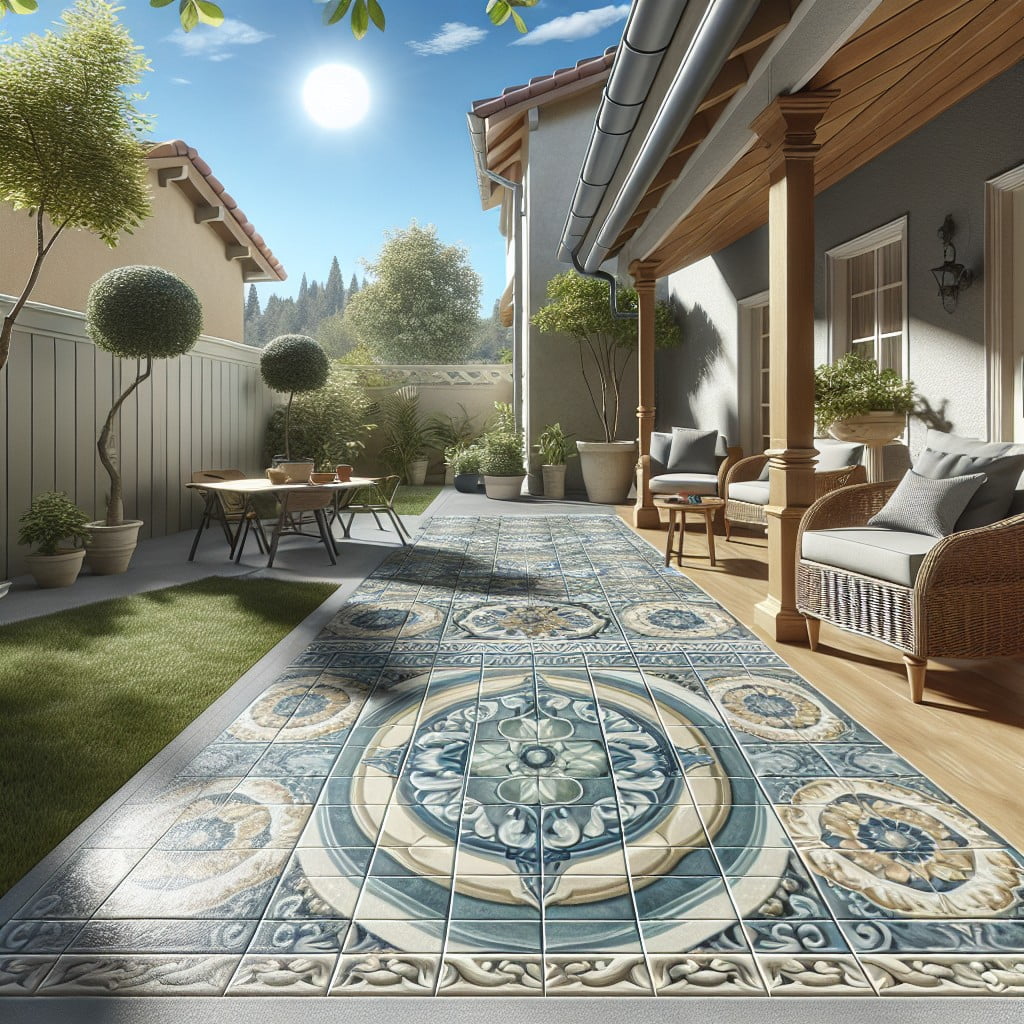Last updated on
While bathroom tiles can technically be used outdoors, they may not withstand severe weather conditions and may become too slippery when wet, making them unsuitable for outdoor use.
Bathroom tiles outside? Absolutely! They can make stunning additions to outdoor living spaces.
Resistant to moisture and easy to clean, bathroom tiles can be repurposed for exteriors.
However, there are essential factors such as durability, slip resistance, and weather tolerance to consider when choosing the right ones for outdoor use.
Stay tuned and find out which bathroom tiles transition well into exterior settings, how to install them, and tips to maintain their aesthetics and functionality outdoors.
Get ready to transform your patio, walkway, or poolside!
Key takeaways:
- Bathroom tiles can technically be used outdoors
- Outdoor tiles are thicker and more durable than indoor tiles
- Indoor tiles prioritize aesthetics while outdoor tiles prioritize durability
- Bathroom tiles may not be suitable for heavy outdoor use
- Consider factors such as weather, slip-resistance, and maintenance when choosing outdoor tiles
Differences Between Indoor and Outdoor Tiles

Outdoor tiles are typically thicker and heftier than their indoor counterparts, designed to withstand harsh weather elements and changes in temperature. These tiles are often crafted from more durable materials like natural stone or porcelain, making them more resistant to damage and wear.
In contrast, indoor tiles often prioritise aesthetics over durability as they aren’t exposed to severe conditions. They include varieties such as ceramic and glass, which provide a diverse range of colors, shapes, and designs.
The surface finish also varies. Outdoor tiles feature a textured, non-slip surface to promote safety, especially in wet conditions, while indoor tiles have a smoother, polished finish for a sleeker look.
Lastly, due to these differing characteristics, outdoor tiles may require more maintenance than indoor tiles. Regular sealing to protect from weathering, staining, and frost damage is often necessary.
Characteristics of Bathroom Tiles

Bathroom tiles are typically designed to withstand wet and humid conditions. They are produced in different materials, including ceramic, porcelain, and stone. Ceramic and porcelain are the most common due to their low absorption rate.
These tiles often sport a glazed finish that offers some water resistance and adds a shiny touch to their overall look – great for bathrooms but possibly too slippery for outdoor use. The glazed surface makes them easier to clean while keeping unwanted mold and mildew at bay.
Additionally, these tiles are usually designed to bear the average footfall of a home and are often available in smaller sizes to accommodate the limited space of a typical bathroom. It’s also worth mentioning that bathroom tiles often have a softer texture in comparison to outdoor tiles, making them more comfortable underfoot. However, this also means that they may not handle heavy outdoor furniture or frequent, rigorous foot traffic as effectively. Most importantly, remember that elegant designs and intricate patterns are common in bathroom tiles, elevating aesthetic appeal and providing a vast array of styling options.
Effects of Weather On Bathroom Tiles

Exposure to varying natural elements can significantly impact bathroom tiles.
Firstly, frequent alternation between heavy rains and scorching sun can cause tiles to expand and contract. This continual process can lead to cracking, particularly in the grouting. Tiles made from non-porcelain ceramic and certain types of natural stone are more susceptible.
Secondly, frost can be another detrimental factor. Tiles absorb water, which freezes in cold temperatures. As the water solidifies, it expands, potentially causing the tile to crack.
Moreover, tiles can fade over time due to UV radiation, losing their vibrant color. This UV damage is particularly noticeable on dark-colored or bold, patterned tiles.
Lastly, prolonged exposure to humidity can cause dampness, leading to mildew or mold growth, especially if not adequately sealed. Humidity resistance is hence a crucial factor to consider.
Remember, different tile materials stand up to weather elements differently, and choosing the right tile for your specific outdoor conditions is key to longevity.
Durability of Bathroom Tiles in Outdoor Conditions

Bathroom tiles, particularly those made from ceramic or porcelain, are designed to withstand high moisture levels and constant use, which provides some durability. However, outdoor conditions present a different set of challenges. Temperature swings, freeze and thaw cycles, and exposure to harsh elements can contribute to cracking and fading over time.
Tile finish also plays a role in its performance outdoors. Glossy tiles may lose their sheen due to weather impact, while those with matte finishes might show stains more readily. Furthermore, lighter shades can help mask these weather-induced changes better than darker ones.
Nonetheless, some high-end bathroom tiles have been successfully used in covered outdoor areas with moderate climates. But, generally tackling the outdoor environment requires a greater level of durability that most bathroom tiles may not possess.
The bottom line is that while bathroom tiles have their advantages, they might not be the best choice for heavy outdoor use. There are other types of tiles specifically designed to meet the challenges posed by the great outdoors.
Sun Exposure and Bathroom Tiles
In terms of solar exposure, most interior bathroom tiles may be unsuitable for outdoor use. The intense, direct sunlight common in outdoor settings can cause fading and discoloration in tiles not specifically designed to withstand it.
UV-stable tiles are recommended for outdoor spaces that are frequently exposed to sunlight. These tiles, unlike regular bathroom tiles, are resistant to the damaging effects of UV rays, and retain their color and strength over long periods.
However, if your outdoor area is sheltered or doesn’t receive much sunlight, less UV-resistant tiles like those used in bathrooms might hold up fine. Just keep in mind, over time, minimal sun exposure can still cause color fading.
An accurately balanced design, taking into account sunlight exposure and tile type, can significantly enhance the longevity and aesthetic appeal of your outdoor space. By carefully considering your specific situation, it’s possible to make an informed decision on the right kind of tile for your needs.
Considerations for Slip-Resistance of Bathroom Tiles Outdoors
The outdoors can be significantly more slippery due to weather conditions such as rain, dew, and snow. Bathroom tiles, usually being glossy, might not provide the traction necessary for safe movement, especially in wet situations.
When assessing use outdoors, keep these factors in mind:
- Texture: Rougher tiles offer better grip when compared to smooth glazed ones. Matt finishes or texturized surfaces could be a safer option.
- Grading: Tiles are rated from R9 to R13 based on their slip resistance. Bathroom tiles are typically lower rated, but for external use, consider tiles rated R11 and above.
- Size and layout: Smaller tiles mean more grout lines, leading to extra traction. Opting for interlocking patterns can also reduce slipperiness.
- Maintenance: Keeping tiles clean from moss, algae, or lichen growth helps maintain slip resistance.
Remember, safety must never be compromised when considering aesthetic appeal. It’s crucial to weigh these considerations alongside design and style preferences.
Pros and Cons of Using Bathroom Tiles Outside
Looking at the positives, bathroom tiles can bring an aesthetic appeal to outdoor settings due to their unique textures, colors, and patterns. Given their smooth surface and resistance to moisture, they can be an excellent option for covered outdoor spaces like screened porches, where they’re shielded from severe weather.
Nonetheless, it’s essential to highlight the drawbacks. Bathroom tiles might not be ideal for open spaces exposed to weather elements. They may not withstand freezing and thawing cycles, which could lead to cracks. Another consideration is their rating of slip-resistance. Bathroom tiles can become slick when wet, making them a potentially hazardous choice for areas subjected to rain or pool water. Lastly, bathroom tiles typically require a fair amount of maintenance when used outdoors to keep them clean and prevent discoloration from prolonged sun exposure.
Outdoor Tile Material Recommendations
When choosing the right tiles for your outdoor space, the material plays a key role. Here are a few popular and durable options:
- 1. Porcelain: Known for its toughness and other attractive qualities like low water absorption rate and wide design variety. Ideal for patio or terraces.
- 2. Natural Stone: These tiles offer a great aesthetic and unique nature-based patterns. However, the durability depends on the stone type. Slate and granite are excellent choices for their strength.
- 3. Quarry: Non-slip and robust, these tiles are great for outdoor spaces that encounter a lot of water, like around pools. They can, however, be prone to staining.
- 4. Concrete: Offers high durability and customizable designs. Requires sealing to ward off stains and moisture.
- 5. Rubber: Soft underfoot and safe. Best used for kids’ play areas or workout spaces.
Each material has its unique benefits and drawbacks. It’s important to align your choice to your needs, considering factors such as local climate, usage, safety, and aesthetics. Remember, the better the quality, the longer the lifespan and aesthetics of your outdoor space.
Factors to Consider When Choosing Outdoor Tiles
Understanding what to take into account when selecting outdoor tiles can heavily influence the longevity and safety of your exterior spaces. First and foremost, durability should be top of mind given that outdoor tiles need to withstand varying weather conditions. High-density tiles are more likely to resist cracking due to freezing and thawing cycles.
Next, consider water absorption. Tiles with low water absorption rates are less likely to warp or become damaged over time. This ties directly into the frost resistance of the tile, as freezing water within the tile can lead to cracks and other damage.
Equally vital is the slip-resistance of the tile. Exterior spaces tend to be susceptible to becoming wet, making it imperative to select tiles with a certain level of grip to minimize the risk of injury.
The aesthetics, while important, should align with the practical factors. Tiles should integrate well with the existing exterior design, so consider the color, pattern, and size as part of your selection process. Always remember, functionality should not be sacrificed for aesthetic alone.
Finally, cost inevitably plays a role. Your choice should balance between your budget and the quality of tiles you’re investing in. Cheap, low-quality tiles might require replacement down the line, leading to higher costs overall. A worthy investment now could save you time and money in the future.
Cost Analysis of Outdoor Tiling Options
Comparing costs involved in outdoor tiling necessitates a thorough understanding of both initial outlay and long-term spending. Material and labor costs contribute substantially to the initial expense. For instance, ceramic tiles are generally more cost-effective upfront than stone tiles, but their longevity differs.
In terms of durability and maintenance, porcelain tiles might have a higher initial price point, but due to their resistance to frost, sun, and scratches, their upkeep costs are likely less over time.
It’s worthwhile to consider the expense of maintaining and potentially replacing lower-cost options. Tiles with a higher slip-resistance rating, like quarry or certain types of stone tiles, are essential for safety, but they might carry a slightly higher price tag.
There may also be hidden costs, like the purchase of sealants for certain types of stone tiles. These costs are important to factor into the budget.
Consider hiring a professional to install outdoor tiles. Although it’s an added expense, a proficient installation can extend the lifespan of the tiles, thereby ensuring value for money in the years to come.
By carefully evaluating these factors, you can make an informed decision about the best tiling option for your outdoor space.
How to Maintain Outdoor Tiles: Tips and Tricks
To maintain your outdoor tiles effectively, there are few key practices to follow. Regularly sweeping or vacuuming them will prevent dirt and debris build-up. Use a mild detergent mixed with warm water for routine cleaning, while avoiding harsh chemicals that can damage tile surfaces.
If you encounter stubborn stains or moss growth, consider using a soft brush to avoid scratching the tiles. Additionally, power washing, preferably annually, can be beneficial in removing grime – but remember to use a low setting to avoid potential damage.
Sealing the tiles can protect them from weather-related damage. However, whether or not your tiles require sealing will depend on the material they’re made from. Porcelains, for instance, rarely require sealing while natural stone tiles may benefit from a quality sealant.
Lastly, assess your tiles for potential damage or wear regularly. This way, you can replace broken or chipped tiles promptly, which will prevent water penetration that could lead to larger issues down the line.
Case Studies: Successful Use of Bathroom Tiles Outdoors
One instance where bathroom tiles were effectively harnessed outdoors was in a private residence in Houston, Texas. The designers utilized porcelain tiles, initially intended for bathrooms, across an expansive patio area. Not only did these tiles withstand the intense summer heat without fading, but they also resisted cracking in winter conditions. Professional sealing helped to bolster durability and prevent water absorption.
In another success story, a hotel in Miami chose bathroom mosaic tiles to stylize an outdoor pool area. These tiles brought an aesthetically pleasing touch while providing the necessary water resistance and slip-prevention qualities. The constant exposure to chlorine, sun, and heavy usage did not cause any noticeable wear over a significant period, resulting in a popular design decision that blended both utility and beauty.
Finally, bathroom ceramic tiles were used effectively in an outdoor restaurant in Seattle. Known for heavy rainfall, choosing the right outdoor material was challenging. They selected ceramic bathroom tiles for their resistance to moisture and easy maintenance. To prevent slipping, a slip-resistant coating was applied over the tiles. These case studies illustrate the potential of bathroom tiles for outdoor applications when chosen wisely and tailored to meet the specific needs of the environment.
Latest Developments in Outdoor Tiling Industry
Technological advancements have notably impacted the outdoor tiling industry, introducing new possibilities and improving upon existing ones. One notable development is the adoption of digital printing technology, which allows for the creation of tiles with virtually any pattern or image, greatly enhancing design flexibility.
Furthermore, manufacturers have made remarkable strides in developing scratch and slip-resistant ceramic and porcelain tiles, highly beneficial for outdoor use. This ensures improved safety and increased longevity, even in high traffic or wet conditions.
There’s also a rising trend towards eco-friendly tiles, made from recycled materials or designed to reduce environmental impact. These tiles not only contribute to conservation efforts but also add an element of sustainability and elegance to your outdoor space.
Lastly, the introduction of frost-proof tiles extends the life of outdoor tiling in colder climates. They resist cracking under freeze-thaw cycles and guarantee durability despite harsh weather conditions, making them an invaluable technological innovation in the industry.
Keep these emerging trends in mind when you plan your next outdoor project; they could bring an extra layer of sophistication and functionality to your outdoor space.
Health and Safety Considerations for Outdoor Tiles
As you transition from indoors to the great outdoors, it’s crucial to bear in mind important health and safety implications. Start with slip resistance: outside surfaces often get wet due to rain or watering plants, making it important to select tiles with a high slip resistance rating.
Next, think about extreme temperatures. In areas with scorching summers or frosty winters, tiles will need to be able to withstand thermal expansion or contractions without cracking.
Consider the fact that tiles reflect sunlight, and some types may become hot underfoot – not ideal for a pool surround or a patio where people may be barefoot.
Lastly, remember to account for tile hardness. Hard tiles are more difficult to cut and lay, potentially leading to safety issues during installation. In addition, dropping items on hard tiles may cause them to chip or break, resulting in sharp edges.
By considering these key factors, you can avoid potential mishaps, and ensure a safe and pleasant outdoor environment.
Where to Buy Outdoor Tiles
Numerous outlets provide a broad range of outdoor tiles suitable for different needs and desires. Local home improvement stores like Home Depot, Lowe’s or Menards have diverse collections. These establishments often have in-store experts to guide your selection process.
Online alternatives offer endless possibilities. Websites such as Wayfair, TileBar, and Floor & Decor have an extensive range of outdoor tile options. These platforms incorporate filters for style, durability, brand, and price to customize your search.
For more specialized and unique designs, consider visiting a tile showroom, where experts can provide in-depth consultations about design and material options. Importantly, always remember to check product reviews and ratings when shopping online. Ensuring to confirm the tile suitable for outdoor use is essential to avoid future disappointments.
FAQ
Can indoor ceramic tile be used outdoors?
No, indoor ceramic tile should not be used outdoors due to its inability to endure weather conditions, insufficient slip and scratch resistance.
Which type of tile is not recommended for outdoor use?
Ceramic tiles are not recommended for outdoor use due to their inability to withstand frost, which leads to cracking in cold weather.
Can indoor wall tiles be used outside?
Yes, certain types of indoor wall tiles, such as standard porcelain tiles, can be used outside due to their high quality, density, and water-resistant characteristics.
What type of tile can be installed outdoors?
Porcelain tile is an excellent choice for outdoor installation due to its superior durability and long-lasting properties with proper installation and maintenance.
How does weather affect the durability of outdoor tiles?
Weather greatly impacts the durability of outdoor tiles, as extreme temperatures, precipitation, and frost can cause fading, cracking, and peeling.
What are some alternative materials for outdoor tiles besides ceramic?
Alternatives to ceramic for outdoor tiles include natural stone, porcelain, slate, and composite decking.
How should tiles be properly installed in outdoor areas for longevity?
Tiles in outdoor areas should be properly installed by setting them onto a firm and well-drained base, using a suitable adhesive, and sealing the grout lines to enhance durability and longevity.
Recap:




